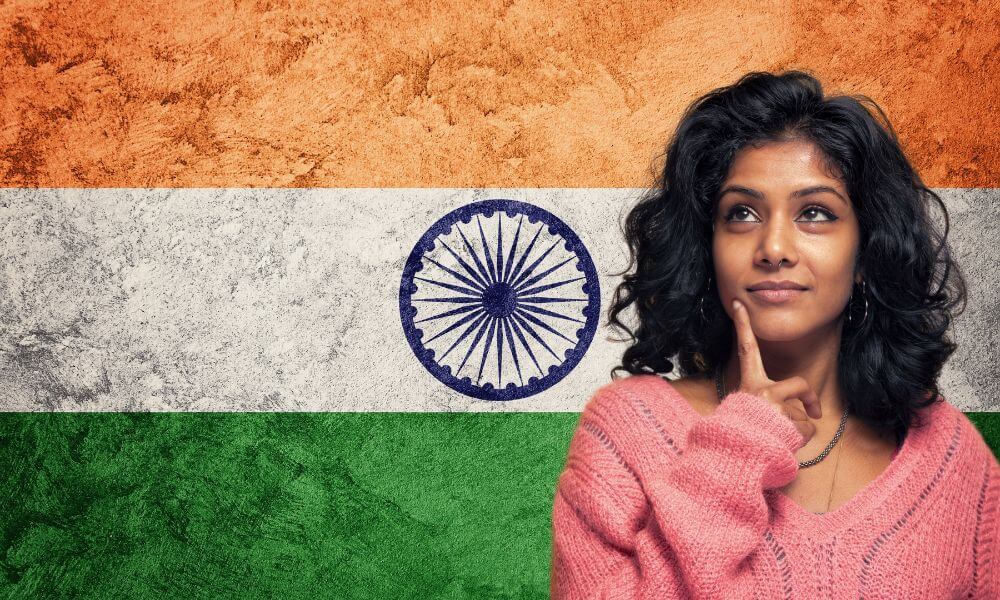Someone from India is called Indian, to put it simply; unfortunately, the real answer is far more complicated. India today is sovereign nation, but the Indian subcontinent is a huge area that encompasses more than one nation as well as literally dozens of ethnic groups. Most probably wouldn’t call themselves Indian.
To make this question a bit easier to digest, the simple way we can break it down is this: if you are a citizen of the modern nation state of India, you are Indian; on the other hand, you may live on the Indian subcontinent in a different nation and thus are not a citizen of India—but may still be “Indian” in some sense.
Let’s find out more.

What is a person from India called?
The short answer is that a person from India is called Indian.
This is the word for a person from the modern nation state of India, whether they are natively born there, descend from parents who lived there, or themselves migrated to the country.
Already, the definition of what an “Indian”, like any nationality, is becoming stretched. But again, the simple answer is just that if they are residentially or ancestrally associated with India in one way or another, they are Indian.
Ethnicity, though, is a far more complex question that we’ll get into shortly.
Firstly, though, it’s worth considering what we actually mean when we say “India” today.
For many, the term “India” is more or less synonymous with South Asia.
India is often called a subcontinent, though many would even argue it is easily big enough to be a continent in its own right.
Either way, when we say “India” generally we mean the country, but the subcontinent called India also contains seven other nations; Bangladesh, Bhutan, the Maldives, Nepal, Pakistan and Sri Lanka.
Even before we get into questions of ethnicity, these people could be said to be “Indian” in some loose sense and yet they likely would not consider themselves so.
Another word you might find useful, then, with this in mind, is “Desi”.
This is a common term used for those who live in or originate from the Indian subcontinent or South Asia and its widespread diaspora.
The question of diaspora is another one to consider; Indian people live all over the world and so there are large populations in other countries that we would still call Indian.
Let’s look at ethnicity, then.
What ethnicity is a person from India?
Firstly, it’s important to note that most ethnic groups in India are defined by the language they speak, rather than genetics or anything else.
Either way, the broader South Asian ethnicities are literally in the hundreds, but there are three main ethno-linguistic groups in the Indian subcontinent: Indo-Aryan, Dravidian, and Iranic.
Though there are so many different groups, one ethnic groups dominates: speakers of Hindi and Urdu, representing around 48% of the population.
Even these people do not identify as a single ethnic group.
Bengalis make up a further 8% of India’s ethno-linguistic makeup, if we are talking about India the nation as opposed to India the subcontinent.
This is naturally a big step down from the largest group, though once again it’s important to stress that Hindi/Urdu speakers representing one group is an outside imposition and not how they would see themselves.
The Marathi people then comprise around 7% of the population, along with the similar populations of Telugu and Tamil. Gujarati comprise a further 4.6%.
The list of ethnic groups in India and the broader Indian subcontinent is long, and perhaps the simpler way of trying to understand the ethnic identity of Indian people as a whole is not to think of them as a unified whole.
Where does the name “India” come from?
Our modern word “India” is accepted to derive from Latin, a word for South Asia and regions further east.
This was derived from Greek Indos, and Old Persian Hindush, referring to a region of the Achaemenid Empire.
Finally, this Old Persian term derived from the Sanskrit Sindhu, meaning river, referring to the Indus River.
Indians tend to refer to their nation as Bharat, or a variation of this name.
Again, this name is ultimately derived from Sanskrit roots in Indian epic poetry such as The Ramayana.
This name gained traction in the 19th Century as a popular native term for India.
Where do Indians live?
There are around 1.4 billion Indians in the world today, and the nation is soon expected to overtake China as the most populous in the world.
With that, naturally, comes a broad Indian diaspora.
There are an estimated 18 million Indians living outside of India, with the largest population living in the United States; around 4.5 million.
A further 3.2 million are found in Saudi Arabia, 2.9 million in Malaysia, and more across Canada, the UAE, the U.K., and Sri Lanka.
The point being that while these people do not live in India, most probably feel themselves to be Indian at least to some extent.
So, again, when you are looking at an area of the world as large as the Indian subcontinent, the answer is never going to be all that simple.
There’s always the question of both national identity and ethnic identity, and neither may be fully adequate to describe what a person feels themselves to be.
Many ethnic groups live in India and may all feel something different about their identity; in the simplest sense, though, they are all Indian.
More in Demonyms
- What Do You Call Someone From Afghanistan?
- What Do You Call Someone From Algeria?
- What Do You Call Someone From Argentina?
- What Do You Call Someone From Australia?
- What Do You Call Someone From Azerbaijan?
- What Do You Call Someone From Bangladesh?
- What Do You Call Someone From Barbados?
- What Do You Call Someone From Belgium?
- What Do You Call Someone From Botswana?
- What Do You Call Someone From Crete?
- What Do You Call Someone From Denmark?
- What Do You Call Someone From Ecuador?
- What Do You Call Someone From Egypt?
- What Do You Call Someone From El Salvador?
- What Do You Call Someone From Fiji?
- What Do You Call Someone From Finland?
- What Do You Call Someone From France?
- What Do You Call Someone From Ghana?
- What Do You Call Someone From Greece?
- What Do You Call Someone From Greenland?
- What Do You Call Someone From Hong Kong?
- What Do You Call Someone From Iceland?
- What Do You Call Someone From India?
- What Do You Call Someone From Ireland?
- What Do You Call Someone From Israel?
- What Do You Call Someone From Japan?
- What Do You Call Someone From Jersey?
- What Do You Call Someone From Jerusalem?
- What Do You Call Someone From Jordan?
- What Do You Call Someone From Kazakhstan?
- What Do You Call Someone From Laos?
- What Do You Call Someone From Malta?
- What Do You Call Someone From Myanmar?
- What Do You Call Someone From Niger?
- What Do You Call Someone From Pakistan?
- What Do You Call Someone From Panama?
- What Do You Call Someone From Peru?
- What Do You Call Someone From Rwanda?
- What Do You Call Someone From Singapore?
- What Do You Call Someone From Sri Lanka?
- What Do You Call Someone From Sweden?
- What Do You Call Someone From Switzerland?
- What Do You Call Someone From Thailand?
- What Do You Call Someone From The Isle of Wight?
- What Do You Call Someone From The Ivory Coast?
- What Do You Call Someone From The Netherlands?
- What Do You Call Someone From Uzbekistan?
- What Do You Call Someone From Vatican City?
- What Do You Call Someone From Wales?
- What Do You Call Someone From Zimbabwe?

